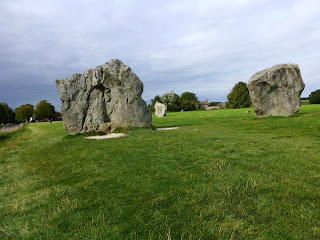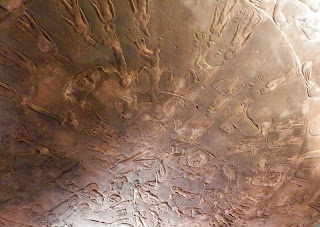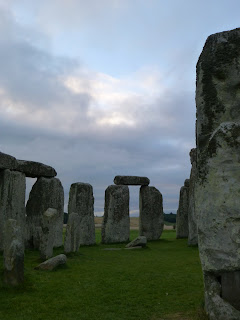I think I felt the standing stones of
Avebury more deeply than Stonehenge. That surprised me, given what I'd been told ahead of my visit, that I probably would not feel as much because the stones had been moved and the energy disturbed. For me, it was wonderful to be able to touch and lean up against the stones, which wasn't allowed at Stonehenge.
 |
| The henge |
Just about the same time we started walking among the stones, the bus from "Hogwarts" showed up. Well, not really, but middle school aged students in uniforms speaking "proper" English. It was fun to watch them experience the stones, out of the corner of my eye, and do their scavenger hunt-like worksheets.
 |
| The henge and circle |
Another Neolithic era monument site, Avebury is the largest "henge," in the UK, defined as a ring earthenwork with a ditch inside its bank. The standing stones are both inside the henge ring (about a mile wide), and outside in avenues leading to the rings (used to be two avenues, but only one exists now). Also, there's a larger ring that encompasses two smaller ones, and the little town is right there--incorporated into the sacred landscape.
Avebury is actually the largest henge in the world, measuring some 1400 feet in diameter, covering 28 acres. If you look at the site from
Bing aerial views, you'll also note the proximity of the site to
Silbury Hill and
West Kennet Long Barrow, and if you expand the view out, you're likely to even see a crop circle or two! Silbury hill is another Neolithic era construction, a conic hill, and the Long Barrow is a burial chamber built into a hillside.
 |
| Avebury circle near village |
Many of the stones were brought down and broken in the 14th century and the stones used to construct buildings in the village. Where the original stones used to stand, the English Heritage group has erected small stone monuments as place-keepers. Of course, in earlier times the magical feel of the stones and circle, as massive and impressively placed as they are, were associated with evil and some were destroyed as a result of their inexplicable nature mixed with superstition.
 |
| "The Devil's Chair" stone on left |
We walked farther away from the center of the site where most people venture, and over towards the avenue, where the standing stones line either side of a pathway through a field where cows are grazing. Along the way, we marveled as we stepped through a "fairy ring" where the ground was depressed so you could tell there had been some sort of building there. As we chatted in the center of circle wondering what it was all about, the light all around us dimmed and changed character and the surrounding field and trees all seemed to get greener.
 |
| The "fairy ring" |
A little ways beyond that our guide brought us to one of the stone that had a wide enough girth for us all to sit against, and we did a journey to connect with the spirits of the land.
 |
| Grove of trees |
Continuing on up the chalk hill (very thin topsoil covers chalk deposits from shell deposits), we came to an amazing group of trees with intertwined roots and prayer ties hanging from the branches. We spent a few minutes connecting with the trees, as it seemed that the outside world was hushed here and the trees had messages to share.
 |
| The avenue with the cows |
And, farther along, walking along side the cows in the avenue, it seemed to me that the stones there still contained their history and power. I felt that one side of the avenue held feminine energy, while the other side seemed masculine.
I was struck at how this must have all seemed in neolithic times, thousands of years ago, when ancient ceremonialists might have walked from sacred site to sacred site at special times of the year, such as equinox or solstice. There is a reverence for the land that permeates the area and draws you into your primal intuition of why our ancestors built these circles and why it was worth their concentrated time, effort and resources at a time when basic survival was primary.
 |
| The Avenue at Avebury |
The land at Avebury seems to have a purpose, a message in existing and surviving. No doubt, that is why the crop circles appear near here, too--whether real or artificial--they are messages created from the land and its natural bounty, singing out to us for attention and reflection. It seemed to call me back from my time of technological advances, world travel, and instant communication.
 |
| One of the avenue stones |
What monuments of our time are we leaving for future generations and will any of it ride out the eons, besides our radioactive waste and pollution? What will our message be, and how will people of the future interpret it?
 |
| A stone on the avenue |
Impermanence and change, perhaps the only common ground. No doubt, these stones will remain.












Comments